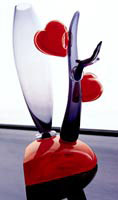Blown away
Salviati has brought Murano glass into the 21st century with a modern range by London designers

What would an artist, an architect, a product designer and the head of Habitat all have in common? The answer is glass. Not the glass of industrial creation and mass production, but that precious, hand-crafted and malleable material from the Italian island of Murano.
Salviati meets London is a project marking the marriage of eminent names such as Nigel Coates, Anish Kapoor, Tord Boontje, Tom Dixon and Simon Moore, and one of Murano’s most notorious art glass companies, Salviati. The project is to be shown at Vessel, Nadia Demetriou Ladas’ specialist tableware shop in London. Always one for exploiting the potential of stoneware, china and glass, she has rounded up this unusual quintet to produce a series of limited edition pieces. “We chose a person from each discipline and each product reflects their background. For example, Coates’ and Kapoor’s pieces are organic and fluid, while Dixon – who is a master of mass production – has created three geometric sets,” says Demetriou Ladas.
Under the guidance of glass maestro Simon Moore, formerly the head of Salviati design studio and now managing director at Dartington Crystal, each creative has had a go at leaving their mark on glass. Coates, who has worked with Moore before, employed the Venetian technique of “incamiciata”, multilayers of coloured glass which, coupled with light reflection, create a one-off palette of hues. Product designer Boontje has transposed embroidery precision on to Venetian “cristallo”, with embossed bunnies, horses and butterflies. Moore himself has created an “island” series, heavyweight pieces with sculptural components.
Of all the people involved, it was Kapoor, according to Moore, that approached the project in a totally different manner. “[With him] it was much more sculptural, and as a result each piece is different”, he says. While for most designs Moore managed to translate the brief to the artisans in the Salviati workshops, for Kapoor it was necessary to work together in London, since most of his creations are conceived as a work in process, with the final designs yet to be confirmed.
The results are striking, with all the designs making use of the two most significant qualities of Murano glass: chromatic vibrancy and light texture. Perhaps the project will spark off an interest in Murano glass within a larger audience, including those not familiar with its history of craftmanship. According to Demetriou Ladas, glass blowers’ knowledge was so revered during the Venetian Republic that they were forbidden to leave the island lest they took their secrets with them. In exchange for this “golden exile”, they were granted special privileges, such as the option of marrying into Venetian aristocracy. Historically, Salviati has always had a British connection – its mosaic tesserae can be seen on London’s St Paul’s Cathedral cupola, and a portrait of Prince Albert – a gift from the Italian factory to Queen Victoria – is at the Victoria and Albert museum. Art critic John Ruskin even advised discerning British travellers on the Grand Tour to take at least one Murano object home with them.
Yet interest in modern Italian glassware has somewhat fizzled out over the years, with serious collectors and connoisseurs mainly coveting 1950s and 1960s pieces from that other great producer, Venini. “In the last 40 years the mantle of modern design in glassware has been taken over by the Scandinavians,” explains Demetriou Ladas. “Now Salviati is getting rid of 80 per cent of their traditional lines to focus on contemporary design.”
The first examples of this new approach can be seen at Vessel from 3 October, to coincide with the London 100% Design Show.
Salviati meets London, at Vessel from 3 October until 11 November, 114 Kensington Park Road, London W11
-
Post a comment




